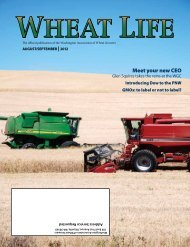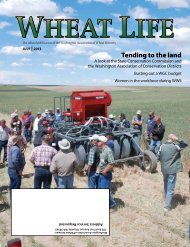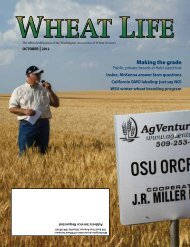Download - Wheat Life
Download - Wheat Life
Download - Wheat Life
Create successful ePaper yourself
Turn your PDF publications into a flip-book with our unique Google optimized e-Paper software.
WGC REPORTS WL<br />
The three hard wheat “briefs” published in 2005 by the Washington Grain Commission.<br />
to re-evaluate spring wheat yield potentials before the<br />
remainder of the N is applied at or near planting.<br />
The timing of fall fertilization for DNS and hard white<br />
spring is critical. Early fall application is desirable in low<br />
rainfall areas to ensure adequate time for some of the<br />
N to convert from the ammonium form, which is not<br />
mobile in soil, to nitrate (mobile form) and move down<br />
the profile with over-winter precipitation. In high rainfall<br />
zones, late fall application after soil temperatures have<br />
dropped below 50º F is recommended. This not only limits<br />
the conversion process, it also helps to prevent excessive<br />
movement within the soil profile and the potential<br />
loss of nitrates through leaching out of the root zone.<br />
Monitoring. When yield potentials increase due<br />
to favorable weather conditions, grain protein potential<br />
will decrease unless additional N is supplied to compensate<br />
for the higher yield. Hard wheat growers should<br />
periodically evaluate whether the yield potential of the<br />
crop has increased and ask themselves whether the N<br />
supply (Table 1) is still adequate given the higher yield<br />
potential. If not, supplemental N should be applied as<br />
early as possible to adjust for the higher yield potential.<br />
Tissue sampling can be used as a guide to determine<br />
whether a crop contains adequate nutrients at various<br />
growth stages. Whole-plant samples can be tested for N<br />
and S content and compared to established critical values<br />
to determine sufficiency. Many commercial agronomic<br />
labs in Washington are capable of performing tissue testing<br />
services. For DNS, a flag leaf N concentration of 4.5<br />
percent at flowering is associated with 14 percent grain<br />
protein.<br />
Adjusting. In situations where an adjustment in<br />
the N program is necessary to respond to a higher yield<br />
potential, an in-season application may be warranted.<br />
Late winter/early spring applications of N can effectively<br />
supplement pre-plant applications and help achieve yield<br />
and protein goals. Research shows the earlier in-season<br />
applications can be made on dryland winter wheat the<br />
better. Positive yield and protein response diminishes<br />
with later in-season applications and may lower test<br />
weights in low rainfall areas. Some consultants also recommend<br />
a small amount of S be applied with in-season<br />
WASHINGTON GRAIN COMMISSION<br />
WHEAT LIFE JANUARY 2012 57










